View in other NatureServe Network Field Guides
NatureServe
Montana
Utah
Wyoming
Idaho
Wisconsin
British Columbia
South Carolina
Yukon
California
New York
Mud Amnicola - Amnicola limosus
General Description
Amnicola is a genus of very small freshwater snails (generally <0.5 inch tall) that have an operculum which can seal the interior soft tissues of the shell from the environment. The shells are globose and typically about as wide as they are tall. Length is typically only a few millimeters (mm). They can be fairly tolerant of warm water and low oxygen conditions. Generally shell color is tan to light brown.
Diagnostic Characteristics
Generally shell color is tan to light brown. Not many other dextral snails with operculum are this light color.
Species Range
Montana Range
Range Descriptions
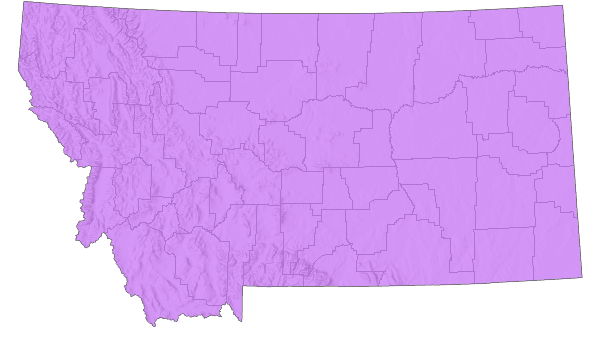
 Native
Native
Range Comments
Amnicola limosa is widespread throughout eastern North America, from Canada to Florida, ranging at least as far west as Utah (Berry 1943). In Montana, records occur from the eastern part of the state in prairie streams and springs to central Montana transitional trout streams.
Observations in Montana Natural Heritage Program Database
Number of Observations: 13
(Click on the following maps and charts to see full sized version)
Map Help and Descriptions
Relative Density
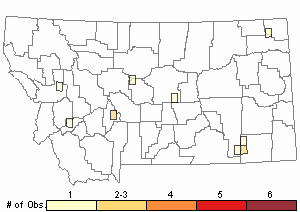
Recency
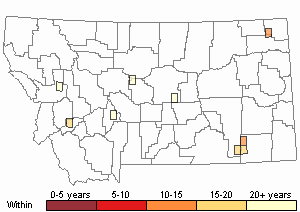
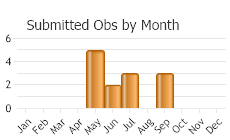
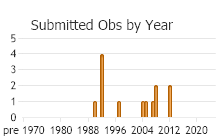
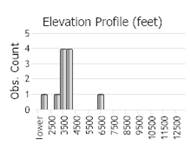 (Observations spanning multiple months or years are excluded from time charts)
(Observations spanning multiple months or years are excluded from time charts)
Migration
Sedentary, not known to migrate.
Habitat
Freshwater. Populations are typically found in lentic environments, but can be commonly collected in slow-moving rivers, often on woody debris.
Food Habits
Amnicola populations appear to be grazers of diatoms and other periphyton (Kesler 1981 and Cattaneo and Kalff 1986). They in turn they are preyed upon by crayfish (Lewis 2001) and sunfish (Osenberg 1989 and Bronmark et al. 1992)
Ecology
Populations are typically found in lentic environments, but can be commonly collected in the slow-moving rivers, often on woody debris. In Montana, outside of stream collections, we found them in the prairie region spring-fed pools on woody debris.
Stewardship Responsibility
References
- Literature Cited AboveLegend:
 View Online Publication
View Online Publication Brönmark, C., S.P. Klosiewski, and R.A. Stein. 1992. Indirect effects of predation in a freshwater, benthic food chain. Ecology, pp.1662-1674.
Brönmark, C., S.P. Klosiewski, and R.A. Stein. 1992. Indirect effects of predation in a freshwater, benthic food chain. Ecology, pp.1662-1674. Cattaneo, A. and J. Kalff. 1986. The effect of grazer size manipulation on periphyton communities. Oecologia, 69(4), pp.612-617.
Cattaneo, A. and J. Kalff. 1986. The effect of grazer size manipulation on periphyton communities. Oecologia, 69(4), pp.612-617. Kesler, D.H. 1981. Periphyton grazing by Amnicolalimosa: An enclosure-exclosure experiment. Journal of freshwater ecology, 1(1), pp.51-59.
Kesler, D.H. 1981. Periphyton grazing by Amnicolalimosa: An enclosure-exclosure experiment. Journal of freshwater ecology, 1(1), pp.51-59. Lewis, J.J. 2001. Three new species of subterranean Asellids from western North America, with a synopsis of the species of the region (Crustacea: Isopoda: Asellidae). Texas Memorial Museum, Speleological Monographs, 5:1-15.
Lewis, J.J. 2001. Three new species of subterranean Asellids from western North America, with a synopsis of the species of the region (Crustacea: Isopoda: Asellidae). Texas Memorial Museum, Speleological Monographs, 5:1-15. Osenberg, C.W. 1989. Resource limitation, competition and the influence of life history in a freshwater snail community. Oecologia, 79(4), pp.512-519.
Osenberg, C.W. 1989. Resource limitation, competition and the influence of life history in a freshwater snail community. Oecologia, 79(4), pp.512-519.
- Additional ReferencesLegend:
 View Online Publication
View Online Publication
Do you know of a citation we're missing? Hendricks, P., S. Lenard, D.M. Stagliano, and B.A. Maxell. 2013. Baseline nongame wildlife surveys on the Fort Peck Indian Reservation. Report to the Assiniboine and Sioux Tribes of the Fort Peck Indian Reservation. Montana Natural Heritage Program, Helena, MT. 83 p.
Hendricks, P., S. Lenard, D.M. Stagliano, and B.A. Maxell. 2013. Baseline nongame wildlife surveys on the Fort Peck Indian Reservation. Report to the Assiniboine and Sioux Tribes of the Fort Peck Indian Reservation. Montana Natural Heritage Program, Helena, MT. 83 p.
- Web Search Engines for Articles on "Mud Amnicola"
- Additional Sources of Information Related to "Snails / Slugs"





